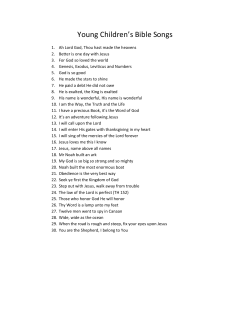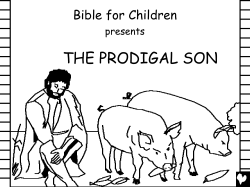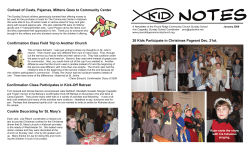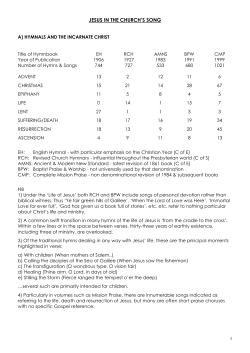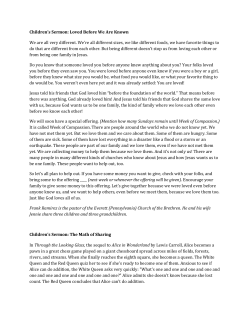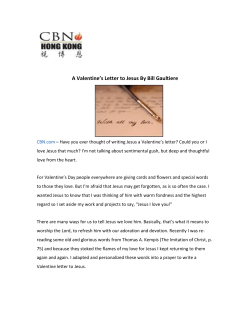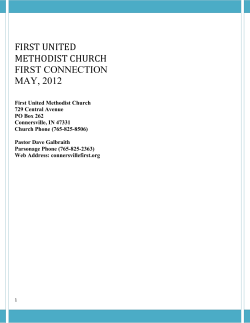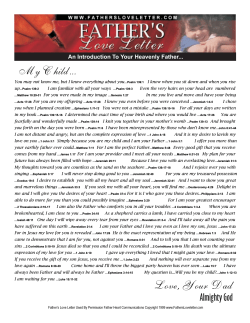
With Our Own Eyes Seven Monologues for Children
With Our Own Eyes Seven Monologues for Children about the Resurrection Appearances of Jesus from the Sacred Seasons Lent/Eastertide 2009 packet Seeds of Hope Publishers With Our Own Eyes Seven Monologues from Seeds of Hope Lent/Eastertide 2009 art that will help the children remember the events. This is designed to be an intergenerational event, with youth and all ages of adults playing the parts and creating the sets. It can be enacted in one event or spread out over the seven Sundays in Eastertide. It could be included in Sunday morning worship or performed in Sunday school. We encourage you to be creative. You will find an overview of the resurrection appearances, and how we arrived at the arrangement of the scenes, on page 23. —lkc art by Susan Daily, IBVM E ditor's Note: Following are seven monologues written to be enacted for children during Eastertide. These monologues are fashioned after the monologues of the Easter Walk, created by Seventh & James Baptist Church in Waco, Texas, several years ago and published by Seeds of Hope. The scenes are based on the resurrection scenes from the four Gospels and from the Acts of the Apostles and are arranged in a somewhat chronological manner. They include the final scene from the Easter Walk—the testimony of the three women at the tomb compiled from Matthew, Mark and Luke, Mary Magdalene, the Emmaus Incident, two testimonies from Thomas, breakfast by the sea in Galilee, and the ascension. Each Maundy Thursday at Seventh & James, seven of twelve available scenes are set up in different rooms in the church buildings and outside on the church grounds. During the first year, we borrowed costumes from the Baylor University theater department—mostly rough or loosely woven tunics. (Costume professor Sally Askins—now the Seeds of Hope Council president—later helped us to make costumes to put in our Easter Walk closet.) Outer garments were created by wrapping lengths, of various woolens and woven fabrics with “ethnic” stripes, around the body. We also borrowed a few props, such as Roman columns, from the theater. Mostly, however, the props were improvised from furniture that was already in the church. (For instance, the tomb was recreated by making a room dark with several candles, and a white sheet over a coffee table, with a cloth folded on one end. We placed styrofoam “rocks” and small potted trees at the entrance.) On the evening of the Walk, the children went from place to place (with at least two adult sponsors) to hear the monologues that the characters had prepared. After each presentation, the children were invited to ask questions. The players answered questions and posed their own (such as, “Why do you suppose Jesus was so angry that he knocked all these tables over?”) They interacted with the children in character. During the Easter Walk, each player gives the children a token to help them remember the testimony. For instance, the witness in the Upper Room gives them small pieces of cloth to represent towels and help them remember the footwashing. The children carry baskets in which to keep their tokens. This was originally intended to be an alternative Easter basket. You might want to create a token, or perhaps a card from each scene with Scene 1. Three Women at the Tomb Scripture: Matthew 28:1-10, Mark 16:1-8 (9-11), Luke 24:1-12 Setting: The entrance to a tomb. (We set this up by using an empty corner area under a stairwell. The area should be any isolated area that is not well-traveled; it should be a space with which the children are not familiar. An outdoor tool shed would also work. We draped the area with fabric to create the tomb. We used styrofoam "rocks" at the entrance, with a stool covered in fabric for one sturdier rock. We also used a coffee table draped with a white sheet, with a white cloth folded at one end.) The women are dressed like simple peasant women. Sacred Seasons 2 When the children arrive, they are standing around the entrance. One could be sitting on the sturdy “rock.” As they talk, they interrupt one another, and they nod their heads at what one another is saying. They are clearly agitated. FIRST WOMAN: We came here, where they buried our friend and master, to anoint his body with spices, as is our custom of treating the dead. But, well...it’s amazing! As we were walking to the tomb, we had been worried about how we would move the stone that covered the entrance to the tomb. We knew that it was very heavy—too heavy for us to move, and we were hoping that someone would be there to help us. But, as we walked up the path toward the tomb, we saw... SECOND WOMAN: We saw that the stone had already been moved! We were nervous and a little frightened, so we slowed down a little and we looked all around. “Who would roll away the stone from the door of the tomb?” We asked each other. These two pushed me in front and made me go into the tomb first! THIRD WOMAN: Oh, but you should have seen what we saw! There was a young man sitting on the right side of the tomb... FIRST WOMAN: Wearing a white robe! THIRD WOMAN: Yes. And it was the most beautiful white I have ever seen. It almost sparkled! Well, as you can imagine, we were amazed and speechless. After a few moments, we dropped to our knees, out of fear and respect, and bowed to this radiant man. SECOND WOMAN: Then he spoke! “Don’t be amazed,” he said, “you seek Jesus, the Nazarene, who has been crucified. He is risen; he is not here.” FIRST WOMAN: When we heard these words, we all began to cry. He is what?! Risen?! What was that supposed to mean? SECOND WOMAN: But the angel went on. “Come, look at the place where they laid him!” We all got up slowly and walked toward where they had laid Jesus. His garments were there, but his body was gone! It was... THIRD WOMAN: Incredible, amazing, wonderful! Then the angel spoke to us again! “Go quickly, and tell his disciples he is risen from the dead. He goes before you into Galilee; it is there that you will see him.” See him!! We were going to see him alive again! FIRST WOMAN: Well, we were so excited, we couldn’t run fast enough! SECOND WOMAN: The guys didn’t believe us at first. They thought we were crazy! Well, all except for Peter, who Lent/Eastertide 2009 got up and ran to the tomb to see for himself. THIRD WOMAN: And we don’t blame them, not really. We hardly believe it ourselves. That’s why we came back to look again. But it’s true! We just went back inside and He is gone! He is alive! —This monologue, written by Kimmy Scott, is part of the Easter Walk, a dramatic Holy Week event for children, published by Seeds of Hope. Scene 2. Mary Magdalene Scripture: John 20:1-18 Setting: First-century Jerusalem, in a garden, morning. Mary is dressed in modest clothing of the time. MARY: This is where I was when it happened. Jesus had been killed. That was so hard for me. I loved him very much. If you had known him, you would have loved him, too. He treated me—me, a woman—like I was an important person. He worried about poor people and orphans and widows. He talked about people who didn’t have any way to take care of themselves, people who were hungry or thirsty or sick or in prison. He loved us. We knew that, we had no doubt. And he allowed us to love him back. He taught us so much about God and about taking care of each other. He taught us about love. But then he was taken and killed. I had to wait until the Sabbath was over, because you can’t go very far or do any work on the Sabbath. I came out here to the tomb as early as I could on the next morning. It was still dark, but I saw that the stone was taken away from the entrance, and I didn’t know what to do! I thought that someone—maybe the religious leaders or the Romans, I didn’t know—had stolen his body. I was so upset and confused! I ran to where Simon Peter and the others were hiding, and I said, “Someone has taken the body! Come and look!” And Peter and John came running to the tomb with me. They saw where the stone was rolled away, and they went inside the tomb. They saw the linen cloth we had used to wrap the body, but there was no body. It was gone. They left, but I stayed there, outside the tomb. I was weeping. I went to look in the tomb one more time, and what do you think I saw? I saw two angels sitting there! Really! They were sitting where the body had been. They asked me why I was crying. And then I turned around, and there was a man standing there. I thought he was the gardener. He asked me why I was crying, and I blurted it out: “They Sacred Seasons 3 have taken away the body of my Lord, and I don’t know where it is! Do you know where it is?” And he said, “Mary.” And I recognized his voice. It was Jesus! Alive! I ran again to where the disciples were, and I told them that I had seen him and that he had spoken to me—called me by name, but I don’t think they believed me. Do you believe me? —This monologue was written by Katie Cook. Scene 3. Thomas the Twin, part 1 Scripture: John 20:19-25 Setting: Outside, in Jerusalem. Evening, first-century Palestine. You could use a painted backdrop that suggests a Jerusalem street or an olive grove. Thomas is dressed in modest clothing. THOMAS: I can’t believe all that has happened in the last few days. We thought Jesus was the Messiah we had all been waiting for, but he died without delivering us! Who will help us now? Three days ago, Jesus of Nazareth was put on the cross and he died. He was put in a tomb belonging to Joseph of Arimathea. My friends, who, along with me, make up a group of his followers, came running to me just now, saying that they saw him, alive. Impossible! They insist that it is true, but I don’t believe it. They told me that were hiding in the upper room of a house, in a group, talking, when a man suddenly appeared in the room and said, “Peace be with you.” The room was locked, because they were afraid they would be arrested, too, and this man just appeared inside the room! As you can imagine, they were shocked and horrified! They thought it was a ghost. But then he showed them the wounds he got when he was crucified—holes in his hands and feet, as well as a wound in his side from a spear. They said they were still not sure he was a real human being. But he asked for some food. They gave him a piece of fish from their supper, and he ate it while they watched. It was then that they knew he was really alive, and they came running to tell me. But I don’t believe it. Once a man is dead, he is dead. I won’t believe it until I see him for myself, and can put my fingers into his wounds. —This monologue was written by Crystal Goolsby, a writer who lives in Austin, Texas. Part of the monologue is taken from Luke 24:36-43. Lent/Eastertide 2009 Scene 4: The Emmaus Incident Scripture: Luke 24:13-35 Setting: A road in first-century Palestine, daytime. This is written for two speakers, one whose name is unknown and one who is named Cleopas. They are dressed in modest traveling clothes. Scholars say that these two travelers were probably men. FIRST TRAVELER: It was the first day of the week. Cleopas and I walked side-by-side toward Emmaus in a very sad state. So many bad things had happened in the last three days. We asked each other how it could be that the Master came to us and then was taken away so soon. How he could have been handed over so easily. He was supposed to be the one who saved our nation. Instead, he was killed. As we walked, a man appeared in the distance. We had never seen him around before. He walked right up to us and began to walk with us. He asked, “What are you two talking about?” What could we tell him? We felt as though someone very close to us had died. How do you say something like that out loud, though? Finally, Cleopas said to him, “You must be new around here, or else you would have known what happened.” CLEOPAS: But all the stranger said was, “What has happened?” How was it possible that anyone could miss hearing of the events that occurred during the last three days? Nonetheless, we explained to him the amazing and sad events that have taken place. We told him that we were discussing the fate of Jesus of Nazareth—how we thought he would save Israel, but instead he was handed over by the chief priests to the Roman government. How he was nailed to a cross and died, instead of delivering us. FIRST TRAVELER: We also told him about how some women from our group went to Jesus’ tomb earlier that morning, only to find that Jesus’ body was not there! Even more amazing, they said some angels who were sitting by the tomb told them that Jesus was alive! We didn’t believe it when they told us, but some of the men from our group went to check the tomb, and found that the tomb was empty. CLEOPAS: After he heard all of our story, the stranger looked at us, amazed, and said, “All of you people are so foolish! Why is what happened so hard to believe, when it is what the Scriptures say? You know very well that they say that the One to save Israel would have to suffer all the things you just told me about before He was glorified!” He Sacred Seasons 4 then quoted many of the writings of the old prophets that included predictions about Israel’s deliverer. FIRST TRAVELER: By this point we were almost to Emmaus, and we asked the stranger to come and eat with us, and to stay the night with us so that we could keep talking to him. It was getting late, anyway. He agreed to come, and so the three of us went to our house. When we sat at the table, he blessed our food and then passed it out. Suddenly, we realized to whom we had been talking the whole time. We were sitting with Jesus himself, the very man we had been mourning! As soon as we realized who he was, he disappeared from our table. Cleopas and I left the table and ran out to find the other members of our group, who told us that the Lord was risen, and that he had appeared to Peter. CLEOPAS: How amazing! The Master had come to us, and we did not even recognize him! But when he broke the bread for our supper, we suddenly knew it was he! FIRST TRAVELER: And how wonderful it is that he is alive once again. —This monologue was written by Crystal Goolsby, a writer who lives in Austin, Texas. Scene 5. Thomas the Twin, part 2 Scripture: John 20:26-29 Setting: A week after the first appearance. An interior room with a long rustic table, set as though a simple meal has just been concluded. It is evening. The room should be darkened, with lamplight or candlelight. Thomas is dressed in the clothing of a person of modest means in first-century Palestine. THOMAS: I have a confession to make to all of you. I am the one who told you I didn’t believe any of these stories about Jesus being risen from the dead. This is the place that the others saw Jesus a week ago. They were here again tonight, but I was with them this time. And what do you think happened? A man suddenly appeared in the room, like they described, and it looked just like the Master! But, I said to myself, it can’t possibly be true. The man said, “Peace be with you,” to the whole group. Then he turned to me and said, “”Thomas. Put your finger here. Look at my hands. Reach out your hand and put it into my side. Stop doubting and believe.” So I did what he told me. I actually put my fingers into his wounds and felt that it was real flesh! I was astounded. I exclaimed, “My Lord and my God!” Lent/Eastertide 2009 Jesus was happy that I now believed that he was alive, after I saw and touched him, but still he told me, “Because you have seen me, you have believed. Blessed are those who have not seen and yet have believed.” If only I had believed it was really he when my friends told me they saw him. I am ashamed that faith was not enough for me, but I am happy that he showed himself to me. And I know he loves me. I will never doubt him again. —This monologue was written by Crystal Goolsby, a writer who lives in Austin, Texas. Scene 6: Peter, Breakfast by the Sea Scripture: John 21:1-23 Setting: first-century Galilee, the beach at the Sea of Tiberius. Very early Morning. Peter looks like he has dressed in a hurry. His hair is wet, and his clothing is partly wet. PETER: It’s a true miracle! The Master has risen and come back to us. I would feel better about it if I had not said on the day that he was arrested that I did not know him. It was exactly what he had told me earlier that night at dinner—that I would deny him three times before morning. And that is what I did. I was so ashamed! But since then, He has risen and appeared to us—to me and his other followers. This weekend, several of us are spending some time at the Sea of Tiberias. I spent hours fishing last night with my friends, but we did not catch a single fish! We continued to fish all night, with growling stomachs and empty nets. Just as the sun was rising, we saw a stranger on the shore. “Who can that be?” I thought. He asked us if we had any fish, to which the answer was still no. He told us to put our net out on the other side of the boat. And to our amazement, it filled with fish, so many that we could hardly lift it! We brought them to the shore, overjoyed that at last we could have a good meal. When we got closer to shore, we realized that the man was not a stranger at all. John said, “It’s the Lord!” And you know me—I jumped out of the boat. He told us to come have breakfast with him, and of course we did so, gladly. He cooked some of the fish that we had just caught. After breakfast, Jesus pulled me aside. I knew what he was about to say. He was about to talk to me about how I denied that I knew him. But all he said was, “Simon son of John, do you love me more than these?” I was surprised, but I said, “Yes, Lord, you know I love you.” Sacred Seasons 5 “Then feed my lambs,” he said. And then again he asked, “Simon, son of John, do you truly love me?” And I said, “Yes, Lord, you know that I love you.” “Take care of my sheep,” he replied. He asked again, a third time, “Simon, son of John, do you love me?” I was hurt. How could he not believe me? I had told him twice that I love him, and he is the Master—he should already know! All I can say is, “Lord, you know all things, you know that I love you.” Again, he told me to feed his sheep. Then he says, “When you were young, you could do what you wanted and take care of yourself. One day, when you are older, people will do with you what they want to do, spread your arms, and take you where you will not want to go.” He is telling me that I will be killed like him one day! But all I can do is accept it; I cannot change it. I already know that what he predicts will come true. But, for now, I am back in his company and I no longer have to feel guilty for what is past. —This monologue was written by Crystal Goolsby, a writer who lives in Austin, Texas. Scene 7: The Ascension Scriptures: Matthew 28:16-20; Luke 24:44-53; Acts 1:3-11 Setting: First-century Palestine (exact location debated), sometime after all of the other appearances. The speaker can be any one of the disciples, dressed in modest clothing of the day. The setting could be like the upper room of Thomas’s second monologue, or it could be outside, during the day. DISCIPLE: Many wondrous things have happened during these recent days. Our Master was taken and executed, and we thought all hope was lost. But now, he is alive again! He has performed many wonderful acts since his return. We, his followers, have seen him many times. Finally, one night at dinner, he told us not to go anywhere but to stay in Jerusalem. He told us to wait for the baptism of the Holy Spirit, which He says is better than being baptized with water. The last time we saw him, we asked Lent/Eastertide 2009 him if he was still going to deliver Israel—if he was going to do what we had all expected the Messiah to do. But he said that it was not for us to know that. He promised that the Holy Spirit would come and help us and that, after the Holy Spirit comes, we will take his message to all of the nations of the earth. But we must be patient and wait. He promised that he would always be with us, even to the end of the earth, the end of time. And then the clouds in the sky opened up, and he started going up into heaven. We looked around, and two men were standing where he had been. They said that he will come again, the same way he went up that day. We were amazed at that, and at all of the things he did and said since that morning when he first appeared to the women outside his tomb. Ånd now we must go back and pray, and wait, as he told us to do. —This monologue was written by Crystal Goolsby, a writer who lives in Austin, Texas. What Was Jesus Trying to Tell Us? I n the Gospel of Matthew, chapter 23, Jesus is teaching in Jerusalem and he unleashes a diatribe against the scribe and Pharisees. At the end, he quotes one of the Psalms in a lament over the city, saying that he longs to gather Jerusalem’s children together as a hen gathers her brood—but the city is full of stubborn, misguided people. What was Jesus trying to tell his followers? What was he trying to tell the religious leaders of his day? What is he trying to tell us? He talked about the poor and the marginalized more than anything. “I was hungry and you fed me,” he said. “You give them something to eat.” “I want you to be servants, not masters.” “Don’t worry about tomorrow.” “Love God with all your heart, and love your neighbor as yourself.” “Love your enemies.” What do we do with these sayings? How are we supposed to be like this man? The “WWJD” trend has, in some ways, cheapened the question, “What would Jesus do?” But it’s still a good question. In fact, I think it’s one of the most important questions we will ever ask. In any given situation, what would Jesus do? If we don’t ask it as individuals, we might very well be missing the whole point of the gospel. If we don’t ask it as a people, we might very well see Jesus looking out over our nation, our churches, and grieving for our stubbornness. —Katie Cook, adapted from “Missing the Point,” in Formations, Smyth & Helwys Sunday school curriculum for adults, the lesson for Lent, 2004. Sacred Seasons 6 Overview of the Resurrection Appearances Early on the First Day of the Week, Jerusalem Luke 24:1-12, Mark 16:1-8; Matthew 28:1-10 Some Galilean women on the first day of the week (including Mary Magdalene, Mary the mother of James, and Joanna—Mark says Salome) John 20:1-18 Mary Magdalene The Same Day, on the Way to Emmaus Luke 24:13-35 The Emmaus incident (including Cleopas) That Evening, Jerusalem Luke 24:36-43 John 20:19-25 Appearance to the disciples, without Thomas A Week Later, Jerusalem John 20:26-29 Appearance to the disciples, with Thomas Sometime Later, Galilee John 21:1-23 Several disciples, breakfast by the sea Sometime Even Later, in Galilee Matthew 28:16-20; Luke 24:44-53; Acts 1:3-11 Last group of disciples, the ascension T he oldest written records of Jesus’ resurrection appear in four of Paul’s letters (Romans 1:3-4; 1 Corinthians 15:3-5; Philippians 2:6-11; Colossians 1:15-20*) and in the book of Acts. (Acts 2:23-24; 2:32; 3:15; 4:10; 10:40) These passages include brief reports of Jesus’ appearing to different apostles, some including Simon Peter by name. The gospels, written later, relate longer narratives of Jesus appearing to various groups and individuals. All four gospels tell of the women at the empty tomb, and all four mention Mary Magdalene by name. Mark’s gospel relates several appearances briefly in chapter 16 and foretells an appearance in Galilee, which is reported in Matthew 28. Luke 24 includes stories in and around Jerusalem, and John 20-21 includes stories from both Judea Lent/Eastertide 2009 and Galilee. An attempt to place all of these appearances in chronological order would be a frustrating exercise. We have it from all of the gospels that women went to the tomb early on the first day of the week, found it empty, and encountered messengers who told them that Jesus had been raised from the dead. However, the gospels all diverge at that point. They differ in the ways they relate the Sunday morning story. For instance, in Mark—except for the portion that was, according to scholars, added later—the women encounter at the tomb a young man dressed in white and are too afraid to tell anyone what they saw. In Matthew’s version, the women witness the removal of the huge stone that blocks the opening and are told by one angel that Jesus is no longer there. Then the women see Jesus alive on their way home. In Luke’s gospel, the women see two men in dazzling robes and return to tell the others—who don’t believe them—except, perhaps, for Peter, who needs to make sure and goes to the tomb, finding it empty. John has Mary Magdalene going to the tomb alone and encountering Jesus. Then she goes and tells the disciples, at which point Peter and John (or the “Beloved Disciple”) go to see for themselves. The subsequent resurrection appearances are even more diverse in the four gospel accounts. The only consensus is that—either on that Sunday, a week later, or forty days later—Jesus appeared several times to various people. These groups and individuals include—besides the women—Simon Peter, a gathered group on that Sunday evening, “the eleven,” James (traditionally James the brother of Christ), five hundred “brethren,” seven people by the Sea of Galilee, and other groups rather vaguely identified. Luke, in chapter 24—the final chapter in the gospel— relates the finding of the empty tomb by the women, the Emmaus episode, Jesus appearing to the disciples (minus Thomas) in Jerusalem, and Jesus’ final appearance and ascension. In the book of Acts, the author continues the story of the ascension. —This piece was adapted from “Practicing Resurrection” by Katie Cook, in Formations, Smyth & Helwys Sunday school curriculum for adults, Easteride 2004. Sacred Seasons 7 benediction Get on out of here, little children, for you and we and all the people of the world are God's children. Get on your way, brothers and sisters together, and of all people, because of Jesus who names and claims us all as his beloved siblings. Get yourself out of this sacred place, pushed by the spirit who blows when and where she will, making all places sacred. Go and do some more singing and talking, laughing and crying, hugging and holding, by which you are strengthened to be tellers of truth, bearers of justice, offerers of resistance, so becoming part of the great cloud of witnesses. Go also to do some sleeping and resting, anticipating tomorrow, which will be another Easter day of God's wonderful surprises and God's true successes. Go now, people of faith. Amen! —John Furry is a minister in Woodstock, Ontario. This benediction was written for a worship service at the summer conference of the Baptist Peace Fellowship of North America. Lent/Eastertide 2009 Sacred Seasons 8
© Copyright 2025
